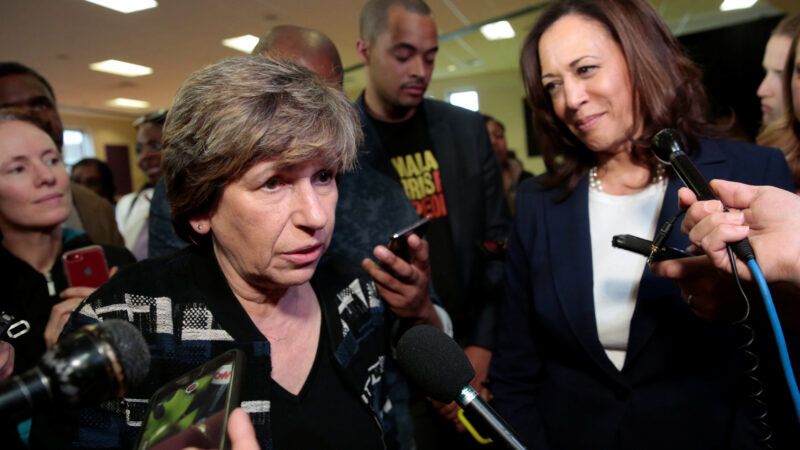Everybody Except Teachers Unions Loves the CDC's Revised School Distancing Guidelines
By moving the recommended distance from six feet to three feet, the CDC brings the U.S. back in line with science, and hastens full school reopening.

As foreshadowed last week, the Centers for Disease Control and Prevention (CDC) Friday morning shortened its recommended distance between K-12 students from six feet to three feet, a change that could hasten full-time schooling for millions of remote and hybrid learners.
"We don't really have the evidence that 6 feet is required in order to maintain low spread," CDC Community Interventions and Critical Populations Task Force leader Greta Massetti told the Associated Press.
The funny thing is, they didn't really have that evidence five weeks ago, either, yet that didn't prevent the CDC from issuing a global outlier of a school reopening guidance that, if followed to the letter, would have kept most American public schools half-open at best well into the fall.
The negative reaction to that teachers union–influenced February 12 document, not just from outspoken school-opening advocates such as Florida Gov. Ron DeSantis but also scientists, left-leaning media outlets, and some Democratic-run polities, undermined the CDC's credibility, and led directly to several school districts delaying or even reversing plans to reopen.
The new recommendations include bringing down plastic barriers ("We don't have a lot of evidence of their effectiveness," Massetti told the A.P.), maintaining six feet of distance in middle and high schools in high-spread communities, and having everyone wear masks.
The revision brings the CDC closer in line with the epidemiological and pediatric researchers, the global public health community, and the professed opinion last July of its current director, Rochelle Walensky. But one category of "stakeholder," unsurprisingly, isn't happy: teachers unions.
"They are compromising the one enduring public health missive that we've gotten from the beginning of this pandemic in order to squeeze more kids into schools," American Federation of Teachers (AFT) President Randi Weingarten told The Washington Post this week. "I think that is problematic until we have real evidence in these harder-to-open places about what the effect is."
Weingarten, a frequent guest of the Biden White House, has, like other union leaders, sought to portray herself as a tireless advocate for reopening while practically throwing up one objection after another when full-time schooling gets near.
Look, you need to have all the mitigation strategies in place before you can actually have a conversation about distancing. Teachers still want and need 6 feet, especially becausre many districts haven't been able to meet other guidelines https://t.co/USO7eBVEbT
— Randi Weingarten ???????????????????????????????????? (@rweingarten) March 17, 2021
On one hand, you can understand why the unions are so chippy. Having isolated themselves on the science of school spread, alienated parents with reckless accusations of racism, and leveraged their significant influence on Democratic politicians to help make the United States a world leader in shuttered schools, the guilds are coming under increasing public criticism. Including from leading New York mayoral candidate, Democrat Andrew Yang, who took aim at the city's United Federation of Teachers (UFT) in a Politico interview this week: "I will confess to being a parent that has been frustrated by how slow our schools have been to open, and I do believe that the UFT has been a significant reason why our schools have been slow to open."
(Retorted UFT President Michael Mulgrew, lamely: "The UFT was the leading force in New York City public schools opening and opening safely, protecting students and staff. Mr. Yang needs to do his homework.")
On the other hand, unions just received a no-strings-attached $200 billion gift from the federal government via an American Rescue Plan that spends most of its K-12 component on hiring, even at a time when schools have been closed and students have been exiting public schools.
Mulgrew, and the New York City Department of Education, illustrate how even policies that are labeled as "reopening" end up with a school experience as anything but. My NYC kindergartener, who is podding a few feet away from me as I type, attends a school of more than 800 kids, where—per city policy arduously negotiated by Mulgrew—the whole institution, already operating at half-time capacity because of the six-foot rule, will shut down if there are two concurrent positive cases of COVID-19.
Weingarten has repeatedly touted New York City (as opposed to, say, the state of Florida, where schools have been open five days a week since September) as a national model. Today's long-overdue CDC revision will hopefully instead make Gotham a stingy outlier in an increasingly vaccinated K-12 world that's accelerating toward full reopening. As New York magazine's Jonathan Chait put it this week, "Just Reopen the Schools Now."
The Department of Education on Wednesday said that a whopping $122 billion from the recently passed American Rescue Plan will be disbursed to public schools by the end of March. An additional $10 billion is being spent by the Department of Health and Human Services on school COVID testing by early April. The unions got their massive payday. Time to go to work.
Show Comments (85)